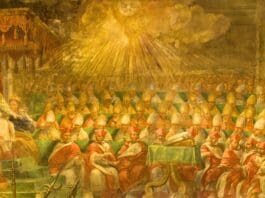
Pope Saint Sylvester, whom God appointed to govern his holy church in the first years of her temporal prosperity and triumph over her persecuting enemies, was a native of Rome and son to Rufinus and Justa. His pontificate was one of the most important, crucial and eventful of all Popes.
He entered among the clergy of Rome and was ordained priest by Pope Marcellinus, during the terrible persecution of Diocletian. His strength during this time won him great esteem among the members of the Church. Upon the death of Pope Miltiades in 314, Sylvester became Bishop of Rome.
After the persecutions and prodigious effusion of Christian blood during the space of the first three hundred years after the founding of the church, the persecuting kingdoms at length laid down their arms and submitted to the faith and worship of God crucified for us.
During Sylvester’s reign occurred the battle of the Milvian Bridge. Constantine’s victory at this battle over his rival Maxentius on the 28th of October 312 was pivotal for Christianity. Before the battle, there was a vision of the Christian Cross, or Chi-Rho, superimposed on the sun; and the words “In This Sign, Conquer”, “In hoc signo vinces”.
Constantine had this symbol painted on the shields of his soldiers, won the battle, became emperor of Rome and ultimately legalized Christianity with Edict of Milan.
Also during Sylvester’s pontificate were built the great churches founded at Rome by Constantine, e.g. the Lateran basilica, the basilica of the Sessorian palace (Santa Croce), the Church of St. Peter’s in the Vatican, and several cemeterial churches over the graves of martyrs. No doubt the pope helped towards the construction of these churches.
In addition, during his reign, great Church councils were held against the heresies of Donatism, Quartodecimans and Arianism at Nice and Arles that preserved the Orthodoxy of Christianity.
St. Sylvester greatly advanced religion by a punctual discharge of all the duties of his exalted station during the space of twenty-one years and eleven months; and died on the 31st of December 335. He was buried in the cemetery of Priscilla. Pope Sergius II translated his body and deposited it under the altar in a church dedicated to God in his memory. Mention is made of an altar consecrated to God in his honour at Verona, about the year 500; and his name occurs in the ancient Martyrology called St. Jerome’s, published by Florentinius, and in those of Bede, Ado, Usuard, &c. Pope Gregory IX, in 1227, made his festival general in the Latin church; the Greeks keep it on the 10th January.
His feast is given under 31 December in the “Depositio episcoporum”, or list of the burial days of the Roman bishops, which was compiled barely a year after his death; the same date is given in the “Calendar” of Philocalus. This day, therefore, is doubtless the day of his burial.
Editorial credit: Renata Sedmakova / Shutterstock.com
The post Pope Saint Sylvester appeared first on uCatholic.
Daily Reading
Memorial of Saints Basil the Great and Gregory Nazianzen, Bishops and Doctors of the Church
Readings for the Memorial of Saints Basil the Great and Gregory Nazianzen, Bishops and Doctors of the Church Reading 1 1 John 2:22-28 Beloved: Who is the liar? Whoever denies…
Daily Meditation
A Voice in Today’s WildernessUna voz en la jungla de hoy día
Click here for daily readings Today’s Gospel passage is especially relevant as we begin a new year with resolutions and hope. In this reading we hear John’s declaration echoing the…




